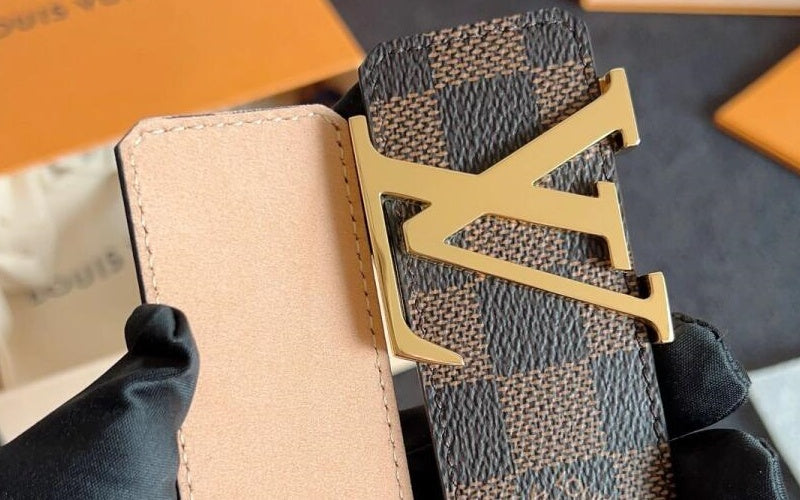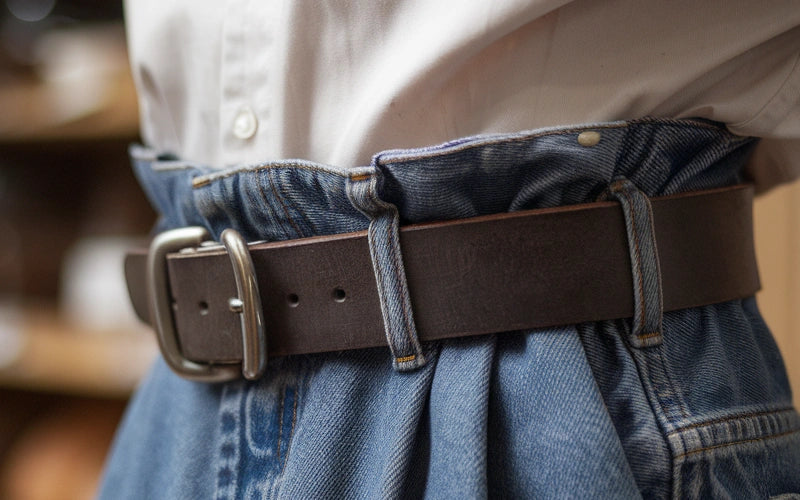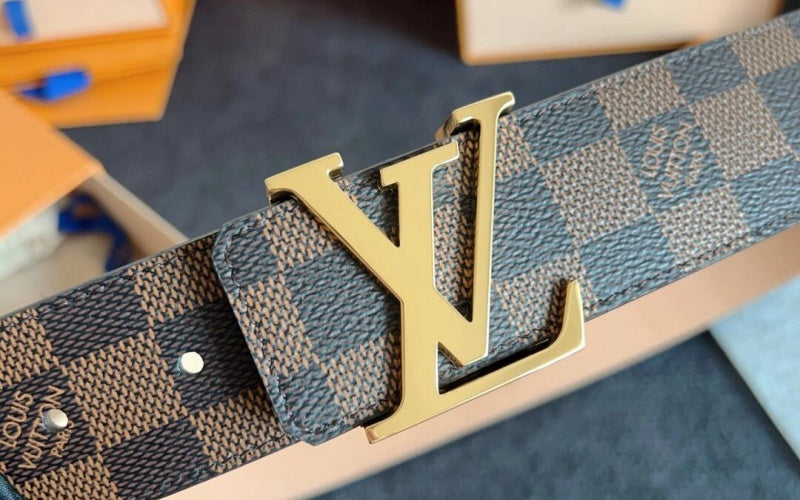
What Are Louis Vuitton Belts Made Of? (and Why It Matters)
Let’s get one thing straight: When you buy a Louis Vuitton belt, you’re not paying for leather—you’re paying for a logo.
But behind that iconic monogram lies a cocktail of materials, marketing, and myths that most sales associates won’t tell you.
At Beltley, where transparency is king, we’re dissecting LV’s secret recipe, exposing why their belts crack, fade, and disappoint, and why luxury should mean longevity.
 Like this belt? Click the image above for more MEW styles.
Like this belt? Click the image above for more MEW styles.
The Louis Vuitton Belt Breakdown: Materials Under the Microscope
Louis Vuitton belts aren’t crafted—they’re assembled. Here’s the real ingredient list:
1. Coated Canvas: The Monogram Money-Maker
-
What It Is: A cotton-polyester blend coated with plastic (PVC) and stamped with LV’s signature pattern.
-
Used In: 80% of LV belts, including the iconic Monogram and Damier collections.
-
Pros:
-
Lightweight.
-
Resists scratches (temporarily).
-
Cons:
-
Cracks like drywall: The PVC coating peels after 2–3 years of regular wear.
-
Non-breathable: Traps sweat, leading to odor and staining.
-
Eco-nightmare: PVC is derived from fossil fuels and isn’t recyclable.
Beltley’s Take: “Coated canvas is the fast food of luxury—cheap to make, expensive to sell, and leaves you feeling empty.”
2. Taïga Leather: The Stiff Imposter
-
What It Is: Calfskin leather embossed with a crosshatch pattern and coated with a plastic finish.
-
Used In: LV’s “men’s” belts like the Taïga Tourbillon.
-
Pros:
-
Scratch-resistant (thanks to the plastic topcoat).
-
Looks sleek out of the box.
-
Cons:
-
Feels like cardboard: Zero flexibility, so it digs into hips.
-
No patina: The plastic coating prevents natural aging.
-
Cracks at stress points: Especially around belt holes.
Beltley’s Alternative: Our Veg-Tanned Heroes use full-grain leather that softens and shines over time—no plastic needed.
3. Epi Leather: The Colorful Deception
-
What It Is: Calf leather pressed into a textured grain and dyed with bold, fade-prone colors.
-
Used In: LV’s seasonal collections (think neon pinks and electric blues).
-
Pros:
-
Unique texture.
-
Eye-catching colors.
-
Cons:
-
Fades faster than a Snapchat streak: UV exposure turns vibrant hues into sad pastels.
-
Prone to scuffs: The embossing flattens with wear.
Beltley’s Fix: Our Chromexcel Collection uses aniline dyes that penetrate deep into the leather, resisting fade and scuffs.
4. Vachetta Leather: The Delicate Drama Queen
-
What It Is: Untreated calfskin used for LV’s trim and buckles.
-
Used In: The Initiales belt’s buckle straps.
-
Pros:
-
Develops a honey patina (if you baby it).
-
Cons:
-
Stains if you breathe on it: Watermarks, oil spots, even sunscreen can ruin it.
-
High maintenance: Requires monthly conditioning to avoid cracking.
Beltley’s Hack: Our Aged to Perfection leather pre-patines naturally, so you skip the stress.
 Like this belt? Click the image above for more MEW styles.
Like this belt? Click the image above for more MEW styles.
The Hardware: LV’s Secret Weakness
That shiny gold buckle? It’s not what you think:
-
Material: Brass coated with a thin layer of gold or palladium.
-
Issues:
-
Plating wears off: After 6–12 months, the base metal peeks through.
-
Screws loosen: LV’s buckles attach with tiny screws that vanish into the abyss.
-
Beltley’s Upgrade: Solid brass buckles with a lifetime tightening guarantee.
 Like this belt? Click the image above for more MEW styles.
Like this belt? Click the image above for more MEW styles.
Stitching & Glue: The Hidden Downfalls
-
Thread: Polyester (not rugged linen).
-
Glue: Industrial-strength adhesive to bond layers (because LV’s leather is too stiff to stitch cleanly).
-
Result:
-
Seams split: Especially where the belt folds.
-
Peeling layers: The canvas/leather sandwich separates with wear.
Beltley’s Craftsmanship: Hand-stitched with waxed Irish linen thread—no glue, just skill.
 Like this belt? Click the image above for more MEW styles.
Like this belt? Click the image above for more MEW styles.
LV vs. Beltley: The Material Showdown
|
Component |
Louis Vuitton |
Beltley |
|
Leather Type |
Coated canvas, plasticized calf |
Full-grain Italian veg-tanned |
|
Hardware |
Gold-plated brass |
Solid brass, nickel, or titanium |
|
Stitching |
Polyester + glue |
Waxed linen, hand-stitched |
|
Eco-Impact |
PVC, fossil fuel dyes |
Vegetable dyes, carbon-neutral |
|
Patina Potential |
None (coated) or high-maintenance |
Develops rich character naturally |
|
Price |
$750–$1,200 |
$295–$595 |
Real Talk: LV belts are like designer paperweights—pretty but fragile. Beltley belts? They’re built to survive your life.
 Like this belt? Click the image above for more MEW styles.
Like this belt? Click the image above for more MEW styles.
Why LV Materials Fail (and How Beltley Fixes It)
1. The Peeling Problem
-
LV’s Issue: Coated canvas and plasticized leather peel like sunburned skin.
-
Beltley’s Solution: Full-grain leather retains its integrity for decades.
2. The Stiffness Struggle
-
LV’s Issue: Taïga leather is about as flexible as a frozen baguette.
-
Beltley’s Solution: Oiled leather that bends like a yoga instructor.
3. The Fade Fiasco
-
LV’s Issue: Epi colors fade faster than your New Year’s resolutions.
-
Beltley’s Solution: Aniline-dyed leather that deepens in color, never dulls.
4. The Maintenance Nightmare
-
LV’s Issue: Vachetta requires babying with $50 LV-branded conditioner.
-
Beltley’s Solution: Leather that thrives on neglect (and our free care kit).
 Like this belt? Click the image above for more MEW styles.
Like this belt? Click the image above for more MEW styles.
FAQs: Your LV Material Mysteries, Solved
Q: Are LV belts real leather?
A: Only partially. Most are coated canvas with leather trim. Beltley uses 100% full-grain leather.
Q: Why does my LV belt crack after a year?
A: The plastic coating dries out and splits. LV’s “leather” is about as real as reality TV.
Q: Can I repair a peeling LV belt?
A: LV charges $200+ for a “spa treatment.” Beltley repairs ours for free.
Q: Is LV’s canvas eco-friendly?
A: PVC is derived from fossil fuels and isn’t recyclable. Beltley uses vegetable-tanned, biodegradable leather.
Q: What’s the most durable LV belt material?
A: None. Even Taïga cracks. For true durability, try Beltley’s Tank Collection.
 Like this belt? Click the image above for more MEW styles.
Like this belt? Click the image above for more MEW styles.
Why Beltley’s Materials Outclass LV’s
-
Full-Grain Leather: Retains natural fibers for strength and breathability.
-
Veg-Tanned: Uses oak bark and chestnuts—no toxic chromium.
-
Hand-Stitched: No glue, no shortcuts, no regrets.
-
Ages Gracefully: Develops a patina that tells your story, not LV’s marketing tale.
Customer Spotlight:
“My LV belt peeled after 18 months. My Beltley belt? It’s survived 5 years of festivals, spills, and bad decisions.” – Jake, Austin
 Like this belt? Click the image above for more MEW styles.
Like this belt? Click the image above for more MEW styles.
The Final Word:
Luxury Should Last (Not Just Look Good)
Louis Vuitton belts are masterpieces of marketing, not craftsmanship. Their materials prioritize logos over longevity, leaving you with a $800 reminder of planned obsolescence. At Beltley, we believe luxury should endure—through rain, sweat, and life’s messy moments.
Ready to Upgrade to Real Luxury? Explore Beltley’s Forever Collection and use code BELTLEY15 for 15% off. Because you deserve a belt that ages with you, not against you.

